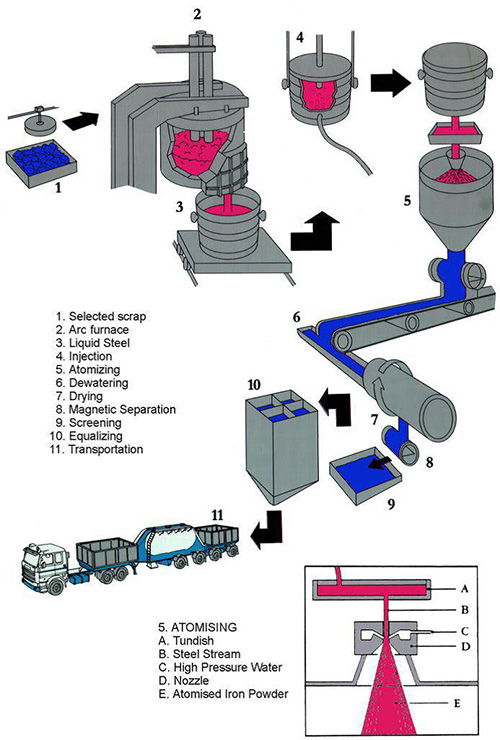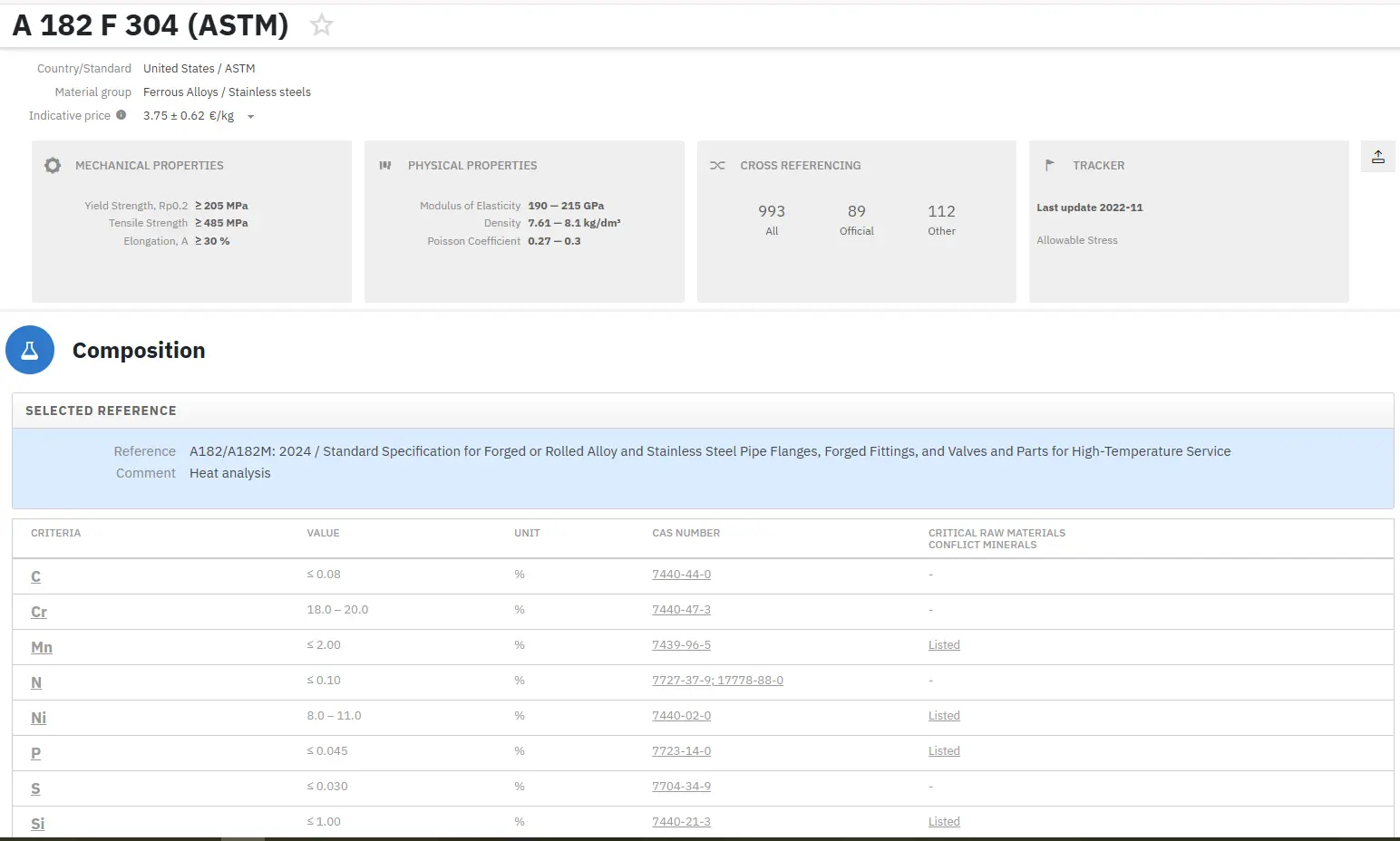The Water-Atomizing Process: Part Two
Abstract
The water atomization process is a huge industry which provides powdered atomized metals to a worldwide customer base for hundreds of different applications.
A tremendous amount of precision work goes into transforming molten raw material into quality checked homogenized powders ready for shipping.
As mentioned in Part One, the atomization is the breaking up of liquid into droplets. If a molten material is atomized into droplets, these normally cool rapidly to produce solid particles. Thus one could say that granulation and atomization are conceptually identical, differing only in the size of particles produced. Granulation produces granules, which may loosely be defined as particles of the millimeter range (sometimes up to >10mm). Atomization is normally taken, in a metallurgical context, to imply that the particles resulting are powder which can loosely be taken to mean substantially sub-millimeter range particles. In fact atomized metal powders are produced with sizes ranging from a few microns to a millimeter. Given that this spans nearly 3 orders of magnitude, the processes used to make and handle particles of the finer and coarser ends of this range are very different.
The Höganäs Water-Atomizing Process
A modern atomizing plant of Höganäs AB is located at Halmstad, a small coastal town 80 km north of Höganäs. The water-atomizing process, as practiced there, can be followed on the flow-sheet shown in Figure 2, and is described in detail on the next page.

Figure 2: Flow-sheet for the Höganäs Water-Atomizing Process.
The raw material for this process is a carefully selected iron scrap and sponge iron from the process described in the preceding paragraph. This raw material (1) is melted down in an electric arc furnace of 50 tons capacity (2) where, if desired, alloying elements can be added. The melt is teemed slag-free through a bottom hole into a ladle (3) where it is refined with an oxygen lance (4). The ladle is then transferred to the atomizing station (5), and the liquid iron (or steel) is teemed slag-free through a bottom hole in the ladle into a specially designed tundish (A).
From there, the liquid iron (or steel) flows in a well controlled stream (B) through the center of a ring-shaped nozzle (D) where it is hit by jets of highly pressurized water (C). The stream of liquid iron (or steel) explodes into fine droplets (E). Some of these droplets freeze immediately into small spheres, others unite in small irregularly shaped agglomerates while freezing.
Air, swept along by the water jet, and water vapor arising in the atomizing process, cause superficial oxidation of the small droplets. The solidified droplets and the atomizing water are collected in a huge container, where they are settle as a mud. This powder mud is de-watered (6) and dried (7). The dry powder is magnetically separated from slag particles (8), screened (9) and homogenized (10), and eventually transported in special containers (11) to the works at Höganäs for further processing.
In the state as leaving the atomizing plant, the atomized powder particles are not only superficially oxidized but also very hard because, due to the extremely high cooling rates residing in the atomizing process, they have solidified in the martensitic state – despite their low carbon content. The powder is, therefore, soft-annealed, and its surface oxides and residual carbon are reduced in belt furnaces of the same type as described in the preceding paragraph. Routines for homogenizing, quality checking, packaging and storing are the same as for sponge iron powders.
Atomized metal powders Polema is Russia’s largest producer of metal powders. The company offers a wide range of alloy powders which are generated when a melt is atomized by high-pressure gas and water. Properties of metal alloys form during melt crystallization. Unlike cast alloys, atomized alloys have a high degree of chemistry and phase homogeneity, uniform structure and grain size. Uniform morphology results from the following: before dispersion the melt is heated until exposed to full destruction of the inherent solid-state structure of the alloy components, and dispersed particles are crystallized during the atomization process at high cooling rates - up to 10,000 degrees per second (gas atomization).
The powders that have undergone gas atomization are characterized by the spherical shape of particles, high flow rate and microcrystalline structure. During water atomization of a melt, the stream is dispersed by virtually overheated pressurized vapor, which forms at the interface between water and the melt. Solid vapor film considerably decreases the cooling rate of the atomized droplets due to impaired heat transfer through the vapor. Water atomized powders have rounded or irregular particle shape, thin dendritic structure, and better compressibility than gas-atomized powders.
Atomized powders produced by Polema are subdivided into two groups: materials for gas thermal spray coatings and constructional powders. The first group comprises over 100 grades of alloy powders for coating using various spraying and surfacing methods: self-fluxing alloys, instrument steel, high-carbon alloys, corrosion-resistant steels and alloys, zinc- and copper-based composition powders and alloys. A wide range of offered coating materials allows meeting specific targets - surface hardening and effective protection against wear and corrosion of vehicle and equipment parts, which operate under high temperature, mechanical stress, exposure to abrasives and aggressive environments.
The second group, constructional powders, includes copper-based press alloys, stainless steels, specific alloys with high magnetic inductivity / permeability (permalloys), materials for shot-blasting surfaces (instrument steels). The materials find application in the production of tools, filters, sintering applications used in machine-building and vehicles, as well as in electrical engineering.
Metalpo Industria E Comércio Ltda
Metalpó is a 100% Brazillian metal powder and PM parts producer, established in 1967. Its main products are self-lubricating bearings and structural parts for the automotive and home appliance markets. Metalpó produces copper powder and its alloys, bronze, brass and tin and lead powders. The PM parts are produced in iron and iron alloys, including stainless steel, bronze and brass. Products are supplied to automotive industries, car assemblers and auto parts producers, and home appliance manufacturers in Brazil and worldwide, exporting to South and North America and Europe. The Metalpó production capacity is about 1,600 tonnes of powders and 120 million PM parts per year, with presses ranging from 4 to 220 tonnes, employing 150 people, with a turnover of R$20 million (approx. US$11.5 million).
Kobe Steel Ltd
Kobe steel is a major producer of water-atomized steel powders and its Steel Powder Department manufactured powders for more than two decades at its original plant in Kobe. In April 1992, Kobe Steel began operating a 6,000 tonnes per month plant with the latest in powder production technology and equipment, providing computerized continuous production at its Takasago Works in Hyogo-Ken.
Read more
Find Instantly Precise Compositions of Materials!
Total Materia Horizon contains chemical compositions of hundreds of thousands materials and substances, as well as their mechanical and physical properties and much more.

Get a FREE test account at Total Materia Horizon and join a community of over 500,000 users from more than 120 countries.